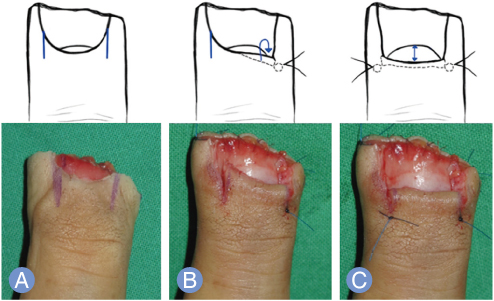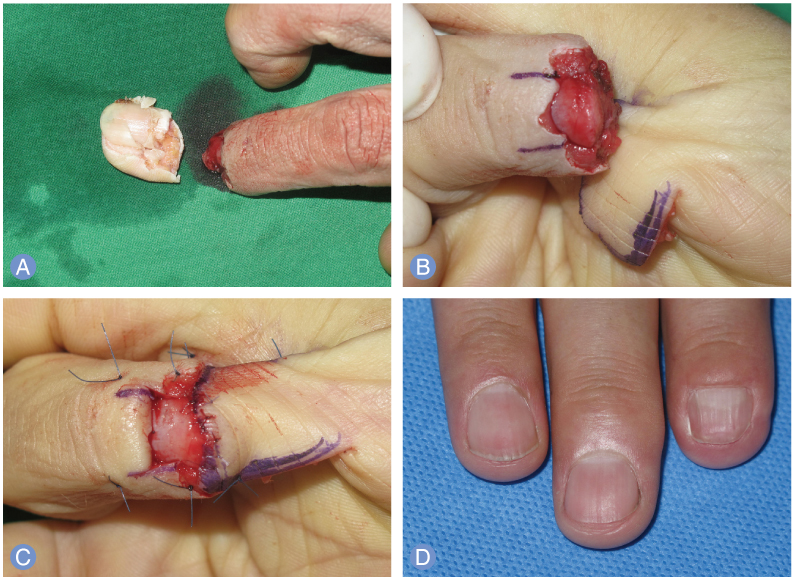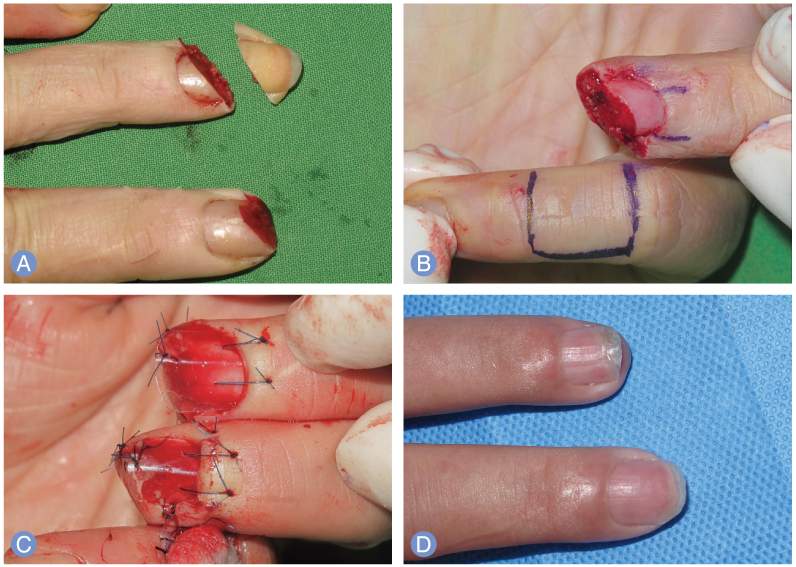J Korean Soc Surg Hand.
2017 Mar;22(1):27-33. 10.12790/jkssh.2017.22.1.27.
Immediate Nail Lengthening with the Eponychial Folding Procedure in Acute Finger Tip Injury
- Affiliations
-
- 1W Institute for Hand and Reconstructive Microsurgery, W Hospital, Daegu, Korea. handwoo@hotmail.com
- KMID: 2375464
- DOI: http://doi.org/10.12790/jkssh.2017.22.1.27
Abstract
- PURPOSE
We present the clinical results and operative method of the immediate eponychium of nail fold set back for lengthening of nails caused by acute fingertip injuries.
METHODS
The research was conducted with a total of 172 patients during the period from January 2014 to June 2016. The operation method was performed in a way to fold down the two sides of the nail eponychium and had suture. A survey of the patients' subjective satisfaction was conducted and the relative nail length was compared before and after the operation as well as the nail length of the uninjured contralateral finger. The mean follow-up period was 18.2 weeks.
RESULTS
In all cases, the operation time was under 3 minutes. There were no specific complications such as nail eponychium's necrosis or congestion. The new nail did not have any additional deformation. On average, the extended nail length was 3.2 mm. Compared with preoperation, the average extension ratio of the nail length was 48%, even with 75% of nail length recovery in comparison with the uninjured contralateral finger. The subjective self-satisfaction score was 92.5 on average. The satisfaction score was higher for patients who had greater remnant nail length.
CONCLUSION
Immediate nail lengthening with the eponychial folding is a simple, safe and useful method with high subjective satisfaction in aesthetics for the patients with acute fingertip injuries.
MeSH Terms
Figure
Reference
-
1. Adani R, Marcoccio I, Tarallo L. Nail lengthening and fingertip amputations. Plast Reconstr Surg. 2003; 112:1287–1294.
Article2. Zook EG, Guy RJ, Russell RC. A study of nail bed injuries: causes, treatment, and prognosis. J Hand Surg Am. 1984; 9:247–252.
Article3. Hosnuter M, Kargi E, Isikdemr A. An improvement in dorsal reverse adipofascial flap for fingertip reconstruction: nail matrix preservation. Ann Plast Surg. 2005; 55:155–159.4. Tamai S. Twenty years' experience of limb replantation: review of 293 upper extremity replants. J Hand Surg Am. 1982; 7:549–556.5. Oh SK, Lee YJ, Lee YK, Woo SH. Immediate full-thickness nail bed graft with various skin flaps for the acute nail bed defects of fingertip injuries. J Korean Soc Surg Hand. 2007; 12:151–157.6. Saito H, Suzuki Y, Fujino K, Tajima T. Free nail bed graft for treatment of nail bed injuries of the hand. J Hand Surg Am. 1983; 8:171–178.
Article7. Hsieh SC, Chen SL, Chen TM, Cheng TY, Wang HJ. Thin split-thickness toenail bed grafts for avulsed nail bed defects. Ann Plast Surg. 2004; 52:375–379.
Article8. Ogo K. Does the nail bed really regenerate. Plast Reconstr Surg. 1987; 80:445–447.
Article9. Endo T, Nakayama Y. Microtransfers for nail and fingertip replacement. Hand Clin. 2002; 18:615–622.
Article10. Kwon ST. Nail reconstruction with distraction lengthening. J Korean Soc Surg Hand. 2007; 12:17–21.11. Xing S, Shen Z, Jia W, Cai Y. Aesthetic and functional results from nailfold recession following fingertip amputations. J Hand Surg Am. 2015; 40:1–7.
Article12. Bakhach J. Eponychial flap. Ann Chir Plast Esthet. 1998; 43:259–263.13. Martin C, Gonzalez del Pino J. Controversies in the treatment of fingertip amputations: conservative versus surgical reconstruction. Clin Orthop Relat Res. 1998; (353):63–73.
- Full Text Links
- Actions
-
Cited
- CITED
-
- Close
- Share
- Similar articles
-
- Nail Lengthening using the Eponychial Flap
- Restoration of the Injured Fingertip with Eponychial Cutaneous Flap
- Nasal tip surgery: nasal lengthening and augmentation in Asian rhinoplasty
- The “Antenna†Procedure for the “Hook-nail†Deformity: A report of 2 cases
- Reconstruction of Central-Type Nail Bed Defect Using a Subcutaneous Flap and Subsequent Nailbed Graft






